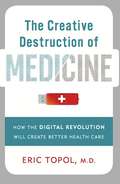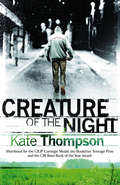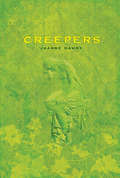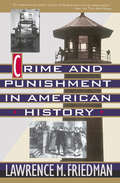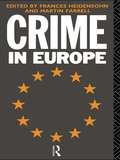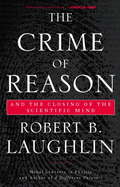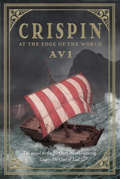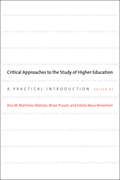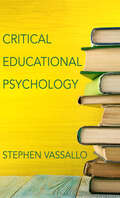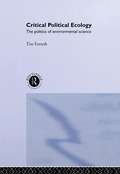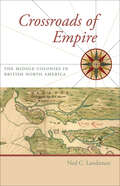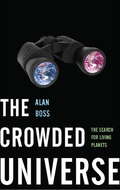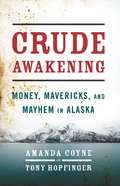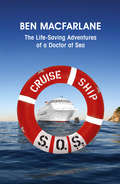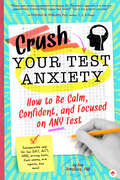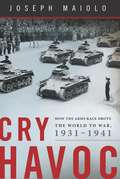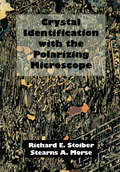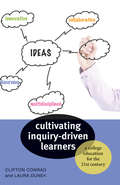- Table View
- List View
The Creative Destruction of Medicine: How the Digital Revolution Will Create Better Health Care
by Eric TopolHow genomics, big data, and digital technology are revolutionizing every aspect of medicine, from physical exams to drug prescriptions to organ transplantsMobile technology has transformed our lives, and personal genomics is revolutionizing biology. But despite the availability of technologies that can provide wireless, personalized health care at lower cost, the medical community has resisted change. In The Creative Destruction of Medicine, Eric Topol-one of the nation's top physicians-calls for consumer activism to demand innovation and the democratization of medical care. The Creative Destruction of Medicine is the definitive account of the coming disruption of medicine, written by the field's leading voice.
Creature of the Night
by Kate ThompsonI could hear Dennis talking to my ma. 'She was little,' he said. 'Little like me. But old. Older than you.' Those words gave me a cold shock. I could see Dennis imagining fairies, but old ones?When Bobby's mother moves the family into a rented house in the country, a neighbour tells him that a child was once murdered there. Bobby doesn't care. All he wants is to get back to Dublin and to resume his wild life there, stealing from the crowded shopping streets and racing stolen cars at night. But getting his old life back doesn't turn out to be so easy, and the longer he spends in the old cottage, the more convinced he becomes that something very strange is going on there. Was there really a murder? And if so, was it the one he has been told about?
Creepers
by Joanne DahmeFrom moving to a new house to making new friends and preparing for high school, life for the new girl in town can be unsettling. But thirteen year-old Courtney is unprepared for how creepy life in Murmur, Massachusetts turns out to be. Her ivy-covered house overlooking the antiquated cemetery next door is one thing, but Courtney finds herself thrust into a full-fledged haunted adventure after meeting Christian and Margaret Geyer, a strange father and daughter with unfinished family business. The body of their ancestor, Prudence, has gone missing from beneath her ivy-carved tombstone and must be returned to its final resting place in order to break the spell that looms over Courtney's house. To add to the suspense and help solve the mystery, authentic documents and photographs are set at the beginning of each chapter pertaining to Murmur, Courtney's house, and the infamous cemetery. Will Courtney uncover the secret lurking within the dark, dank underbelly of her ivy-covered basement?
Crime and Custom in Savage Society: [1926/1940] (Quality Paperback Ser. #No. 210)
by Russell Smith Bronislaw MalinowskiCrime and Custom in Savage Society represents Bronislaw Malinowski's major discussion of the relationship between law and society. Throughout his career he constructed a coherent science of anthropology, one modeled on the highest standards of practice and theory. Methodology steps forward as a core element of the refashioned anthropology, one that stipulates the manner in which anthropological data should be acquired.Malinowski's choice of law was not inevitable, but neither was it unmotivated. Anyone interested in understanding the social structure and organization of societies cannot avoid dealing with the concept of "law," even if it is to deny its presence. Law and anthropology have shown a natural affinity for one another, sharing a beneficial history of using the methods and viewpoints of one to inform and advance the other.The best lesson Malinowski provides us with comes in the last paragraphs of Crime and Custom in Savage Society: "The true problem is not to study how human life submits to rules; the real problem is how the rules become adapted to life." On that question, he has left us richly inspired to continue the quest.
Crime And Punishment In American History
by Lawrence FriedmanIn a panoramic history of our criminal justice system from Colonial times to today, one of our foremost legal thinkers shows how America fashioned a system of crime and punishment in its own image.
Crime in Europe
by Martin Farrell Frances HeidensohnFirst published in 1993. Routledge is an imprint of Taylor & Francis, an informa company.
The Crime of Reason: And the Closing of the Scientific Mind
by Robert B. LaughlinWe all agree that the free flow of ideas is essential to creativity. And we like to believe that in our modern, technological world, information is more freely available and flows faster than ever before. But according to Nobel Laureate Robert Laughlin, acquiring information is becoming a danger or even a crime. Increasingly, the really valuable information is private property or a state secret, with the result that it is now easy for a flash of insight, entirely innocently, to infringe a patent or threaten national security. The public pays little attention because this vital information is "technical”-but, Laughlin argues, information is often labeled technical so it can be sequestered, not sequestered because it's technical. The increasing restrictions on information in such fields as cryptography, biotechnology, and computer software design are creating a new Dark Age: a time characterized not by light and truth but by disinformation and ignorance. Thus we find ourselves dealing more and more with the Crime of Reason, the antisocial and sometimes outright illegal nature of certain intellectual activities.The Crime of Reason is a reader-friendly jeremiad, On Bullshit for the Slashdot and Creative Commons crowd: a short, fiercely argued essay on a problem of increasing concern to people at the frontiers of new ideas.
Crimes of Globalization (New Directions in Critical Criminology)
by Dawn Rothe David O. FriedrichsThis book addresses immensely consequential crimes in the world today that, to date, have been almost wholly neglected by students of crime and criminal justice: crimes of globalization. This term refers to the hugely harmful consequences of the policies and practices of international financial institutions – principally in the global South. A case is made for characterizing these policies and practices specifically as crime. Although there is now a substantial criminological literature on transnational crimes, crimes of states and state-corporate crimes, crimes of globalization intersect with, but are not synonymous with, these crimes. Identifying specific reasons why students of crime and criminal justice should have an interest in this topic, this text also identifies underlying assumptions, defines key terms, and situates crimes of globalization within the criminological enterprise. The authors also define crimes of globalization and review the literature to date on the topic; review the current forms of crimes of globalization; outline an integrated theory of crimes of globalization; and identify the challenges of controlling the international financial institutions that perpetrate crimes of globalization, including the role of an emerging Global Justice Movement. The authors of this book have published widely on white collar crime, crimes of states, state-corporate crime and related topics. This book will be essential reading for academics and students of crime and criminal justice who, the authors argue, need to attend to emerging forms of crime that arise specifically out of the conditions of globalization in our increasingly globalized, rapidly changing world.
Crispin: At the Edge of the World (Crispin)
by AviIn this riveting sequel to the Newbery-Award winning Crispin: The Cross of Lead--the second book in a planned trilogy--Avi explores themes of war, religion, and family as he continues the adventures of Crispin and Bear.The more I came to know of the world, the more I knew I knew it not.He was a nameless orphan, marked for death by his masters for an unknown crime. Discovering his name- Crispin-only intensified the mystery. Then Crispin met Bear, who helped him learn the secret of his full identity. And in Bear-the enormous, red-bearded juggler, sometime spy, and everyday philosopher-Crispin also found a new father and a new world.Now Crispin and Bear have set off to live their lives as free men. But they don't get far before their past catches up with them: Bear is being pursued by members of the secret brotherhood who believe he is an informer. When Bear is badly wounded, it is up to Crispin to make decisions about their future-where to go, whom to trust. Along the way they become entangled with an extraordinary range of people, each of whom affects Crispin and Bear's journey in unexpected ways. To find freedom and safety, they may have to travel to the edge of the world-even if it means confronting death itself.
Critical Approaches to the Study of Higher Education: A Practical Introduction
by Ana M. MartÃnez-Alemán Brian Pusser Estela Mara BensimonCritical theory has much to teach us about higher education. By linking critical models, methods, and research tools with an advocacy-driven vision of the central challenges facing postsecondary researchers and staff, Critical Approaches to the Study of Higher Education makes a significantâ€â€?and long overdueâ€â€?contribution to the development of the field. The contributors argue that, far from being overly abstract, critical tools and methods are central to contemporary scholarship and can have practical policy implications when brought to the study of higher education. They argue that critical research design and critical theories help scholars see beyond the normative models and frameworks that have long limited our understanding of students, faculty, institutions, the organization and governance of higher education, and the policies that shape the postsecondary arena. A rigorous and invaluable guide for researchers seeking innovative approaches to higher education and the morass of traditionally functionalist, rational, and neoliberal thinking that mars the field, this book is also essential for instructors who wish to incorporate the lessons of critical scholarship into their course development, curriculum, and pedagogy.
Critical Care Nursing - E-Book: Diagnosis and Management
by Linda D. Urden Kathleen M. Stacy Mary E. LoughGet a firm understanding and mastery of the unique issues and procedures involved in critical care nursing with Critical Care Nursing: Diagnosis and Management, 8th Edition. Praised for its comprehensive coverage and clear organization, this market-leading text offers a great foundation in the realities and challenges of today’s critical care unit that’s perfect for both nursing students and practicing nurses alike. This new edition also features enhanced integration of QSEN and interprofessional collaborative practice, plus expanded coverage of leadership, post-ICU outcomes and highly contagious infections. Revamped case studies, Patient Teaching boxes, Evidence-Based Practice boxes, Patient Safety Alerts, and other learning tools further develop your critical thinking skills and prepare you for success in high-acuity, progressive, and critical care settings. UNIQUE! Nursing management plans of care feature approximately 35 NANDA-I nursing diagnoses to provide a detailed, ready-to-use, clinically current reference for safe, effective patient care.Consistent organization within each body-system unit provides a systematic framework for learning and for CCRN and PCCN certification preparation. It also serves as a great reference for clinical practice.Pharmacologic Management tables offer quick summaries of the drugs most often used in critical care.
Critical Educational Psychology: An Examination Of Foundational Features Of The Field (Educational Psychology Ser. #15)
by Stephen VassalloThe field of critical studies recognizes that all knowledge is deeply embedded in ideological, cultural, political, and historical contexts. Although this approach is commonly applied in other subfields of psychology, educational psychology;¢;‚¬;€?which is the study of human learning, thinking, and behavior in formal and informal educational contexts;¢;‚¬;€?has resisted a comprehensive critical appraisal. In Critical Educational Psychology, Stephen Vassallo seeks to correct this deficit by demonstrating how the psychology of learning is neither neutral nor value-free but rather bound by a host of contextual issues and assumptions. Vassallo invites teachers and teacher educators, educational researchers, and educational psychologists to think broadly about the implications that their use of psychology has on the teaching and learning process. He applies a wide variety of interdisciplinary approaches to examine the psychology of learning, cognitive development, motivation, creativity, discipline, and attention. Drawing on multiple perspectives within psychology and critical theory, he reveals that contemporary educational psychology is entangled in and underpinned by specific political, ideological, historical, and cultural contexts.A valuable resource for anyone who relies on psychology to interact with, assess, and deliberate over others, especially school-aged children, Critical Educational Psychology resists neatly packaged theories, models, and perspectives that are intended to bring some basis and certainty to pedagogical decision-making. This book will enhance teachers;€™ ethical decision-making and start important new conversations about power and opportunity.
Critical Educational Psychology
by Stephen VassalloThe field of critical studies recognizes that all knowledge is deeply embedded in ideological, cultural, political, and historical contexts. Although this approach is commonly applied in other subfields of psychology, educational psychology;¢;‚¬;€?which is the study of human learning, thinking, and behavior in formal and informal educational contexts;¢;‚¬;€?has resisted a comprehensive critical appraisal. In Critical Educational Psychology, Stephen Vassallo seeks to correct this deficit by demonstrating how the psychology of learning is neither neutral nor value-free but rather bound by a host of contextual issues and assumptions. Vassallo invites teachers and teacher educators, educational researchers, and educational psychologists to think broadly about the implications that their use of psychology has on the teaching and learning process. He applies a wide variety of interdisciplinary approaches to examine the psychology of learning, cognitive development, motivation, creativity, discipline, and attention. Drawing on multiple perspectives within psychology and critical theory, he reveals that contemporary educational psychology is entangled in and underpinned by specific political, ideological, historical, and cultural contexts.A valuable resource for anyone who relies on psychology to interact with, assess, and deliberate over others, especially school-aged children, Critical Educational Psychology resists neatly packaged theories, models, and perspectives that are intended to bring some basis and certainty to pedagogical decision-making. This book will enhance teachers;€™ ethical decision-making and start important new conversations about power and opportunity.
Critical Heart Disease in Infants and Children E-Book
by Ross M. Ungerleider Kristen Nelson David S Cooper Jon Meliones Jeffrey JacobsFeatures comprehensive updates throughout the text, including indications, techniques, potential complications in perioperative management of patients, and surgical techniques for congenital heart disease.Covers recent advances in the treatment of pulmonary hypertension, developments in mechanical assist devices, heart and lung transplantation, and interventional cardiac catheterization.Features an all-new, full-color format that speeds navigation and helps clarify complex concepts.Contains 27 new chapters with an emphasis on the team approach to patient care in the ICU including creating multidisciplinary teams, quality and performance improvement, training , and challenges and solutions to developing a cohesive team environment.Includes a detailed chapter on bedside ultrasound, walking you through the techniques you’re most likely to encounter in the ICU.Employs well-documented tables, text boxes, and algorithms to make clinical information easy to access, and to provide a more complete understanding of echocardiography, imaging modalities, pulmonary hypertension, and more.Describes the basic pharmacology and clinical applications of new pharmacologic agents. Examines issues affecting adults with congenital heart disease.
Critical Political Ecology: The Politics of Environmental Science (PDF)
by Tim ForsythCritical Political Ecology brings political debate to the science of ecology. As political controversies multiply over the science underlying environmental debates, there is an increasing need to understand the relationship between environmental science and politics. In this timely and wide-ranging volume, Tim Forsyth uses an innovative approach to apply political analysis to ecology, and demonstrates how more politicised approaches to science can be used in environmental decision-making. Critical Political Ecology examines: *how social and political factors frame environmental science, and how science in turn shapes politics *how new thinking in philosophy and sociology of science can provide fresh insights into the biophysical causes and impacts of environmental problems *how policy and decision-makers can acknowledge the political influences on science and achieve more effective public participation and governance.
Cross My Heart and Hope to Spy (Gallagher Girls #2)
by Ally CarterAfter the excitement of the fall, all Cammie Morgan wants is peaceful semester at school. But that's easier said than done when you're a CIA legacy and go to the premier school in the world...for spies.Despite Cammie's best intentions, trouble crops up quickly. Cammie, Bex, and Liz learn that the Gallagher Academy is hosting guests from another spy school -- a school that is known to the world as the Ethan Frome Academy--a secret spy school for boys. After her fiasco with Josh last fall, Cammie isn't sure she's ready for daily encounters with boy spies especially after she meets Zach -- an incorrigibe cutie who everyone thinks is just perfect. Cammie is right to be worried about their new guests. Soon after the boys' arrival, she's blamed for a series of security breaches that leave the school's top-secret status at risk. And the perfectly crushable Zach is her prime suspect.
The Crossing
by Andrew MillerShe is sailing. She is alone. Ahead of her is the world's curve and beyond that, everything else. The known, the imagined, the imagined known.Who else has entered Tim's life the way Maud did? This young woman who fell past him, lay seemingly dead on the ground, then stood and walked. That was where it all began.As magnetic as she is inscrutable, Maud defies expectations and evades explanation - a daughter, girlfriend and mother who, in the wake of a tragedy, embarks on a dangerous voyage across the Atlantic, not knowing where it will lead . . .By the Costa Award-winning author of Pure, this is a viscerally honest, hypnotic portrait of modern love and motherhood, the lure of the sea and the ultimate unknowability of others. This pitch-perfect novel confirms Andrew Miller's position as one of the finest writers of his generation.
Crossroads of Empire: The Middle Colonies in British North America (Regional Perspectives on Early America)
by Ned C. LandsmanThis work examines the Middle Colonies—New York, New Jersey, and Pennsylvania—as a region at the center of imperial contests among competing European powers and Native American nations and at the fulcrum of an emerging British-Atlantic world of culture and trade.Ned C. Landsman traces the history of the Middle Colonies to address questions essential to understanding their role in the colonial era. He probes the concept of regionality and argues that while each territory possessed varying social, religious, and political cultures, the collective lands of New York, New Jersey, and Pennsylvania came to function as a region because of their particular history and their distinct place in the imperial and Atlantic worlds. Landsman demonstrates that the societal cohesiveness of the three colonies originated in the commercial and military rivalries among Native nations and developed further with the competing involvement of the European powers, eventually emerging as the focal point in the contest for dominion over North America. In relating this progression, Landsman discusses various factors in the region's development, including the Enlightenment, evangelical religion, factional politics, religious and ethnic diversity, and distinct systems of Protestant pluralism. Ultimately, he argues, it was within the Middle Colonies that the question was first posed, What is the American?An insightful and valuable classroom synthesis of the scholarship of the Middle Colonies, Crossroads of Empire makes clear the vital role of New York, New Jersey, and Pennsylvania in establishing an American identity.
The Crowded Universe: The Search for Living Planets
by Alan BossWe are nearing a turning point in our quest for life in the universe-we now have the capacity to detect Earth-like planets around other stars. But will we find any? In The Crowded Universe, renowned astronomer Alan Boss argues that based on what we already know about planetary systems, in the coming years we will find abundant Earths, including many that are indisputably alive. Life is not only possible elsewhere in the universe, Boss argues-it is common. Boss describes how our ideas about planetary formation have changed radically in the past decade and brings readers up to date on discoveries of bizarre inhabitants of various solar systems, including our own. America must stay in this new space race, Boss contends, or risk being left out of one of the most profoundly important discoveries of all time: the first confirmed finding of extraterrestrial life.
Crude Awakening: Money, Mavericks, and Mayhem in Alaska
by Amanda Coyne Tony HopfingerCrude Awakening is the rollicking story of politics in America’s last frontier and oil province—Alaska, the nation’s most wild and mysterious state, where politics and oil blurred on the day wildcatters struck it big in 1968. Living in a northern Never Land, where oil companies and the federal government kept the state living high and wild, a handful of players ran the show. Among them were the late Sen. Ted Stevens and oilman Bill Allen, the Tony Soprano of Alaska who controlled the political machine until the FBI arrived to root out corruption, only to be accused of playing as dirty as those they were investigating. These characters and events paved the way for Sarah Palin’s rise to fame and fall from glory in Alaska. Authors Amanda Coyne and Tony Hopfinger chart the epic tale of these three characters, set in a state of soaring hopes, fading dreams, drying oil fields and an uncertain future.
Cruise Ship SOS: The Life-Saving Adventures of a Doctor at Sea
by Neil Simpson Ben MacfarlaneWho gets the call if it all goes wrong at sea?Meet Dr Ben MacFarlane. After spending a year as a repatriation doctor, he's heading around the world as a ship's doctor - and with 3,000 passengers and crew to look after he's in for the most exciting trip of his life. On one dramatic voyage he deals with broken bones and broken hearts, and picks up the pieces after fights in the crew bar and freak accidents on shore leave. So join Ben and his colleagues and find out why ship's doctors think bar stools should carry health warnings, why the casino can be safer than the sick bay in a storm and why no amount of sharks, pirates or tidal waves will ever be as dangerous as the midnight buffet.
Crush Your Test Anxiety: How to Be Calm, Confident, and Focused on Any Test!
by Ben BernsteinBased on 40 years of teaching experience and 30 years of clinical psychology experience, Crush Your Test Anxiety distills the best practices used by elite athletes, artists, and top business performers to create a system that can be applied to any test for higher performance.
Cry Havoc: How the Arms Race Drove the World to War, 1931-1941
by Joseph MaioloDid the arms race of the 1930s cause the Second World War?In Cry Havoc, historian Joseph Maiolo shows, in rich and fascinating detail, how the deadly game of the arms race was played out in the decade prior to the outbreak of the Second World War. In this exhaustively researched account, he explores how nations reacted to the moves of their rivals, revealing the thinking of those making the key decisions-Hitler, Mussolini, Chamberlain, Stalin, Roosevelt-and the dilemmas of democratic leaders who seemed to be faced with a choice between defending their nations and preserving their democratic way of life. An unparalleled account of an era of extreme political tension, Cry Havoc shows how the interwar arms race shaped the outcome of World War II before the shooting even began.
Crystal Identification with the Polarizing Microscope
by R.E. Stoiber S.A. MorseSome of the simpler measurements of optical mineralogy are so precise and powerful that they give satisfaction to beginning students. Not long after mastering the strike and dip of rock surfaces with the Brunton compass, many geology students are able to determine precisely the identity of quartz, or the anorthite content of plagioclase, or the magne sium ratio of pyroxene with the polarizing or petrographic microscope, by means of measuring refractive index to better than one part in a thousand. Very little training and almost no theory are needed to achieve these skills. But there inevitably comes a time when theory is needed, either to get on with the art, or simply to reconstruct from first principles what is going on, when rote memory fails. In this book we hope to provide both the rote methods and the theoretical background for practitioners at all levels of experience. We draw from several careers-ours, our colleagues', and our students' -in teaching the subject at various levels of sophistication. Our book is intended to serve the needs of industrial and forensic scientists as well as petrogra phers who deal with rocks. Much of our treatment is based on new research, both in matters of presentation and in the optical determination of minerals and other materials.
Cultivating Inquiry-Driven Learners: A College Education for the Twenty-First Century
by Clifton Conrad Laura DunekInquiry-driven learners anticipate, embrace, and adapt to disruptive change. Clifton Conrad and Laura Dunek advance a transformative purpose of a college education. They invite stakeholders from across higher education to engage in vigorous dialogue about the aims of a college education—and how to realize those aims. Increasingly influenced by market forces, many universities employ a default purpose of a college education: preparing students for entry into the workforce. As a result, students remain unprepared for a world in which much of the knowledge they acquire will have a shelf life of only a few years.Cultivating Inquiry-Driven Learners charts a new way forward. It proposes that a college education prepare students to be innovative and adaptable by developing four signature capabilities: core qualities of mind, critical thinking skills, expertise in divergent modes of inquiry, and the capacity to express and communicate ideas. In concert, these capabilities empower students to explore and foster ideas that will prepare them to successfully navigate constant change, capitalize on career opportunities, enrich their personal lives, and thoughtfully engage in public life.This innovative book also explores a wide range of initiatives and practices for educating inquiry-driven learners. Examples illustrate possibilities for developing inquiry-driven learners across the curriculum and are drawn from institutions with remarkably different missions and identities—from research universities to liberal arts colleges.
